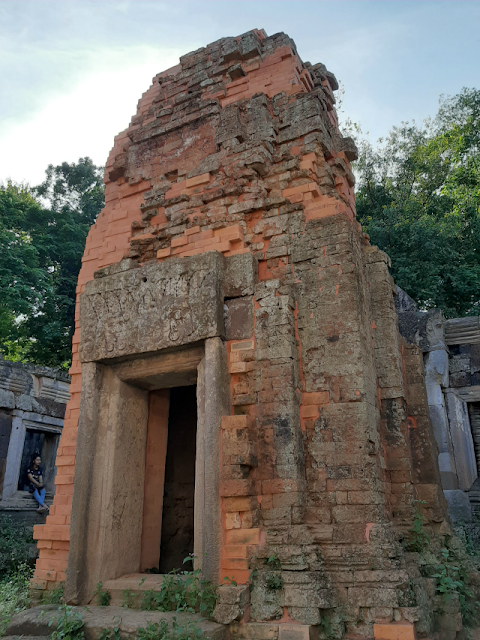The ancient, 11th century temple of Chiso or Chisor is about 42 kms from Phnom Penh and is on 133 meter high mountain.
entrance to temple flanked by white elephants on either side
golden lions
ancestral shrine at the base of mountain
The west entrance near the car park has around to 390 steps
path lined with arjuna trees. Arjuna terminalia is used as a medicine throughout south-east Asia.guardians outside entrance to temple complex

covered area for people to rest
walls covered with events in Buddha's life

small eateries
King Suryavaraman
Khmer empire was ruled by King Suryavarman in the 11th century. He practiced Brahmanism and constructed this temple. It was dedicated to Hindu divinities, Shiva and Vishnu.Its original name was Sri Suryaparvata, Surya: sun, parvata: mountain, or the Mountain of the Sun.



cannon ball or Sala tree
an image of Buddha under Bodhi tree
Mucilanda forms an umbrella over Buddha

the main entrance as was when the temple was built and active
The temple is east facing and there are steps the main entrance
main entrance facing east

Shiva dancing on pedimant, Indra on three-headed Airawat on top of Kaal on lintel

"Kaliya Mardan", young Krishna fighting the serpent Kaliya on west entrance
Kaliya was a very poisonous snake who used to live with his family in the waters of Yamuna. He spewed so much poison that the whole of river became poisonous and no one dared going near it. Krishna, on the pretext of entering the waters, threw a ball into it. He entered the waters, fought with the serpent and when the later asked for forgiveness, Krishna asked him to leave the waters and go away.
a monk poses for a picture, monastery on background
either a sema stone or base for a pillar
Shivyonis in a corner
almost collapsing walls
the lacey work of stone almost resembles that of Banteay Srei
Shiva and Parvati(Uma) on Nandi on pediment
Still functioning temple of bricks and laterite
priest standing at entrance to temple sanctuary
Shivalinga in temple
The central Prasat or the sanctum santorum once had a Shivlinga called Suryavameshwara, ( Surya + Maheshwara) combining the name of King and Maheshwara or Shiva.
broken pieces of pediment
On either side of main shrine are two small identical shrines, vahnigriha or fire shrines. The purpose of these shrines was to provide travellers rest and fire to prepare food. These probably could have been libraries also.North-east shrine
the lintel shows Krishna lifting mount Govardhana on his finger
According to Bhagwat and Puranas, Krishna saw people of Braj, near Mathura making arrangements to please Indra, the god of rain. He asked people not to do so by which Indra got angry and started heavy rains. The heavy down pour continued and people had no where to go. Krishna lifted Mount Govardhana on his pinky finger to shelter the people.
Indra, later realised his mistake and asked for forgiveness.
shrine in south-east
Makar or gargoyle, acting as a spout for water to drain from temple sanctuary
reclining Vishnu under the canopy of Ananta, the celestial snake
a piece of pediment of reclining Vishnu
pediment on north-west
Vishnu on Garuda's shoulder
churning of the sea of milk
three strides of Vishnu
According to Rigveda, King Bali ruled the entire universe, he became very egoistic. Vishnu, in his dwarf form (Vamana) came to the king and asked him for land whihc he could cover in just three strides. Bali, laughingly agreed. Vishnu then showed his gigantic form. In one stride, he covered the whole universe, in second he took the earth and heaven. He had nowhere to put his third stride, the king asked Vamana to place his foot on his head. Vamana was pleased, he placed his foot over Bali's head and sent him to rule the netherworld or Patala which is different than hell or Naraka.

inscription stone

View from above
Two gopurams, Sen Nimol and Sen Roveang had to be crossed before climbing the steep stairs to temple. The gopurams were just like independent temples. Further ahead, Tonle' Om, a baray or lake was considered sacred. Brahmins used to bathe to wash away their sins. So, after taking a dip in baray, one would cross the two gopurams, climb up the stairs and enter the temple.
grass grown steps

entrance to temple seen from below, there are said to be 400 steps, 412
Sen Nimol:
Sen Nimol is now in ruins and heavily overgrown place.
view of temple above from Sen Nimol
inside the sanctuary
Incidents of Buddha's life are painted on wallsLarge parts of the temple were badly destroyed as a result of bombing by US forces in 1973 during Vietnam War, the results of which are still visible.





























































